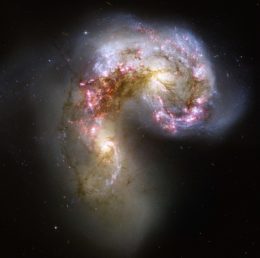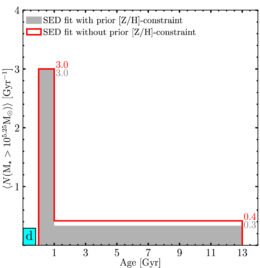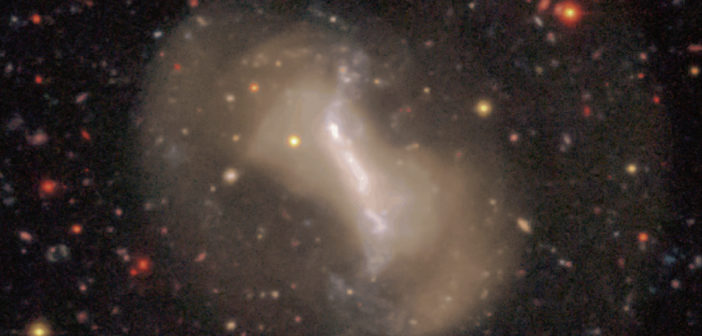What happens when the large-scale drama of a violent galaxy merger plays out on small scales for a pair of dwarf galaxies? New observations document the scene of a recent dwarf-galaxy collision.
Dramatic Encounters

The Antennae Galaxies are an example of a starburst galaxy with rapid star-formation activity driven by a recent merger. [NASA, ESA, and the Hubble Heritage Team (STScI/AURA)-ESA/Hubble Collaboration]
We’ve seen this drama play out on large scales between giant galaxies, but we know a lot less about what happens when dwarf galaxies collide. Dwarf galaxies are the most abundant type of galaxy in the universe, but they’re also very small and faint. This poses a significant challenge to finding and studying dwarfs — which means there’s a lot we don’t know about how the mergers of dwarf galaxies impact overall star formation and the shape of the new galaxy that forms in the collision.

This g-band image of VCC 848 better shows the galaxy’s three extended shell-like structures (outlined with red arcs) surrounding the central body of stars. [Adapted from Zhang et al. 2020]
Feeling Shell-Shocked
VCC 848 is what’s known as a blue compact dwarf galaxy — a small galaxy that’s actively undergoing a burst of star formation. Located in the outskirts of the Virgo Cluster some 65 million light-years away, this little dwarf shows telltale signs of a recent merger: careful analysis reveals a complex set of three extended shell-like structures of stars around the bright stellar main body.
Shell structures — which, previously, had only been detected in larger galaxies — are known to be a signature of a recent minor or major galaxy merger; they are formed as the merger sends ripples through the galaxy and disrupts its structure. The detection of these shells in such a small galaxy provides evidence that we’re looking at the recent merger of two dwarfs.
A Flurry of Activity
Zhang and collaborators use their observations of VCC 848 — made with the MegaCam instrument on the Canada–France–Hawaii Telescope in Hawaii — to analyze the stars of the galaxy and learn more about its history.

The average formation rate per billion years of star clusters above a certain birth mass, for the age intervals of 0–1 Gyr and 1–13 Gyr. This indicates that star formation was significantly more active in the last billion years. [Adapted from Zhang et al. 2020]
VCC 848 is just one of several blue compact dwarfs with hints of tidal shells that the authors uncovered in their survey, so there’s more data on the way! We have a lot more to learn about what happens when tiny galaxies collide.
Citation
“The Blue Compact Dwarf Galaxy VCC 848 Formed by Dwarf–Dwarf Merging,” Hong-Xin Zhang et al 2020 ApJL 891 L23. doi:10.3847/2041-8213/ab7825

6 Comments
Pingback: A Star-Bursting Galaxy Born from the Collision of Dwarfs – Earth Mystery News
Pingback: Galaktyka z aktywnym procesem gwiazdotwórczym narodzona z kolizji dwóch galaktyk karłowatych – PTMA Kraków
Pingback: From AAS NOVA: “A Star-Bursting Galaxy Born from the Collision of Dwarfs” | sciencesprings
Pingback: Una galaxia rebosante de estrellas, nacida por la colisión de enanas – Observatori Astronòmic
Pingback: Una galaxia rebosante de estrellas, nacida por la colisión de enanas « SEDA / LIADA - RedLIADA - Cursos LIADA - Cielo del Mes - Fenómenos Astronómicos - RELEA
Pingback: Una galaxia rebosante de estrellas, nacida por la colisión de enanas « Sección de Astrofísica de la LIADA